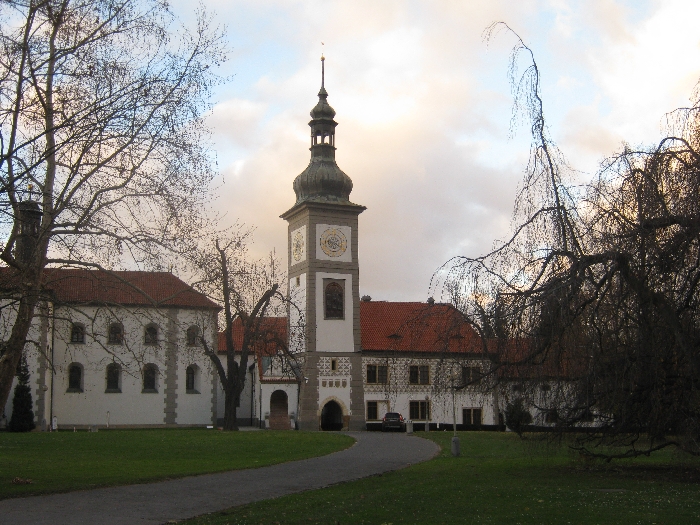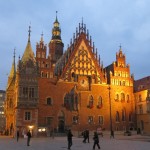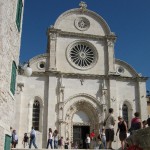
As Sybille and I have, at different times, both made a walking pilgrimage to Santiago de Compostela, ever since moving to Prague more than five years ago, we have sought to discover more about pilgrimage routes that lead from the Czech Republic, via Germany and Switzerland, to link with the well-established paths in France and Spain.
Soon after we arrived in Prague, we managed to purchase a guidebook in German entitled, ‘Der Jakobsweg von Prag bis Tillyschanz/Eslarn‘. It describes a route starting at Kostel sv. Jakuba / Church of St. James, located in the Old Town centre of Prague, heading in a roughly south-westerly direction to the German border at Tillyschanz, a small village four kilometres from the Bavarian town of Eslarn. The guide is the work of three Germans and one German-speaking Czech and suggests that it is possible to complete the journey in ten days.
Over the past five years, we have from time-to-time talked about trying to use this guidebook and walk from Prague to the German border. But for a variety of reasons, the idea has never until now, become a reality. However, last Monday on my day-off, we finally set out to explore a short section of the route just outside the confines of the city of Prague.
We were particularly keen to discover how well the route is waymarked. We were already aware that there are no yellow arrows or scallop shell markings, showing the way from Kostel sv. Jakuba, through the Old Town, across Vltava River and out of the city. But both the German guide and my 1: 50 000 Turistická Mapa, seemed to indicate that waymarking should exist, beyond the outskirts of Prague.
We took the train out to the small town of Radotin, and following lunch in a town centre bar-restaurant, found the route where it passes through Namestí sv Petra a Pavla, the square in front of the parish Church of Radotin, dedicated to St. Peter and St. Paul. It was here that I photographed the sign at the beginning of this post. The little blue and gold scallop shell emblems, show that the route from Zbraslav and heading via Vonoklasy to Karlštejn, is part of the Svatojakubská cesta – the Way of Saint James.

As the sign also indicates, it is a ‘red route’ and therefore waymarked with by red and white marks, very similar to the French balises that mark long distance footpaths in France. At this point, it is also part of a European long distance footpath, the E10. We set out and walked towards Zbraslav, heading back towards Prague. The route took us over this footbridge across the Berounka River. Red and white waymarks were plentiful making the route quite easy to follow.

As we walked down a steep wooded path towards Zbraslav, through the trees we were able to see this former monastery below us, with a Church dedicated to St. James – its small tower with a golden orb and cross, is just visible in the photograph. Unfortunately, the whole complex is now in private hands and appears not to be open to the public. I took the photograph below, by putting my camera through the metal gates that keep the grounds around the former monastery, secure from interested intruders 🙁

In the main square of Zbraslav is where unfortunately, waymarking of the pilgrimage route comes to an end. The red route/E10 heads eastwards across a bridge over the Vltava River, whereas the pilgrimage route to/from Prague, remains on the western side of the river. So far as we can establish, there is no waymarking at all between Prague and Zbraslav.
However, there are much more encouraging signs further west. Whilst our German guidebook only describes the route from Prague to Tillyschanz, it does mention an alternative more southerly route, that leaves the one described in the guidebook at Karlštejn, and heads via Príbram and Klatovy, and then crosses the border about six kilometres before reaching the small Bavarian town of Eschlkam. Between Príbram and Klatovy, is the small town of Nepomuk, where my friend Adrian Blank is based, who has regularly helped me with repairs and servicing of my car.
On the outskirts of Nepomuk, there is another Kostel sv. Jakuba / Church of St. James by which this more southerly route passes. When visiting Adrian in January earlier this year, I discovered a display board near the Church with a map showing this pilgrimage route, together with this newly installed sign indicating the distance to Santiago de Compostela.





Thanks, Ricky, for documenting this portion of the trail. In these days of neglected trails walkers need all the help they can get.
Cheers,
To be fair Michael, the Czech Republic has a great network of walking trails which in our experience, are usually very well waymarked. It’s just a shame that the route from the centre of Prague out to Zbraslav, described in German in our guidebook, has no waymarking on the ground.
That is pity, but what send email on http://www.kct.cz/ ? Klub ceskych turistu – they makes waymark…
It is a pity Lucie, that the route out of Prague isn’t waymarked. The KCT do a wonderful job right across the country, in waymarking attractive paths to walk. But they tend not to do so in urban areas which is why I guess they have never waymarked a path from the centre of Prague to Zbraslav.
I can foresee a walking holiday following the Way coming up, Ricky. 🙂 I wouldn’t have guessed that Santiago de Compostela was seen as a pilgrimage goal from so very far away.
You can foresee very accurately Perpetua 🙂 Sybille is actively planning to walk from Prague – Santiago next year, probably starting in May – June 2014. They’ll be more here about that in due course.
Are there any hostels for pilgrims in Czech Republic. Thx
Hello Codex Calixtinus – what a wonderful name 🙂
This is something we are still in the early stages of exploring, but it does seem that some Roman Catholic parishes are trying to offer simple places to stay overnight for passing pilgrims. Also, accommodation costs in penzions & the like in the Czech Republic, are relatively cheap, compared to neighbouring Germany.
In Czech is normal sleep in woods 😀 Like is http://kniga.rajce.idnes.cz/2013_04_12-13_Vandr_na_Rokytnou/#S7300293.jpg
Yes Lucie – I’ve that this what people do in the summer. Or take a small tent, but that promptly means extra weight to carry.
Hello again, Ricky,
My wife and I have thought about trying the “Way of St James”, but seriously doubt whether the 2893km can be managed on foot in ten days! I’ve read that ten days may be just possible from the French/Spanish border.
Actually I’d not heard about it until I came to Prague, and now on my trips around Europe I often notice the waymarks which sometimes appear in the most unlikely of places!
All the best, as ever
richardinprague
+?
Hello again Richard. You need about four months to walk to Santiago de Compostela from Prague, but as my wife has already commented on a later post http://rickyyates.com/2014-the-year-ahead/, a small number of people do so each year. Even from the French/Spanish border, you need a minimum of four weeks. I know, because I walked it in 29 days back in October/November 2003.
Yes – routes are now being waymarked across Central Europe, to link with the long established routes in France, that lead to the Spanish border. And according to the Pilgrim Office in Santiago, there is a marked increase in people who make a long distance pilgrimage from their homes, rather than travelling to a starting point in France or Spain.